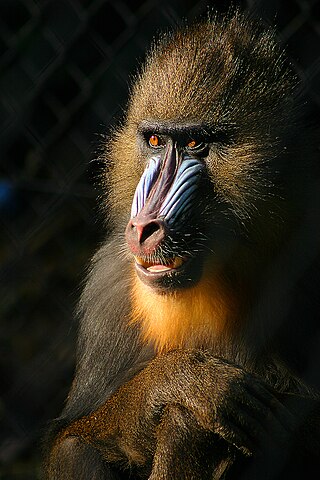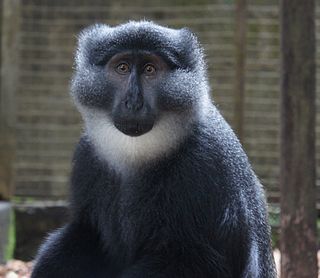
Mandrillus is a genus of large Old World monkeys distributed throughout central and southern Africa, consisting of two species: M. sphinx and M. leucophaeus, the mandrill and drill, respectively. Mandrillus, originally placed under the genus Papio as a type of baboon, is closely related to the genus Cercocebus. They are characterised by their large builds, elongated snouts with furrows on each side, and stub tails. Both species occupy the west central region of Africa and live primarily on the ground. They are frugivores, consuming both meat and plants, with a preference for plants. M. sphinx is classified as vulnerable and M. leucophaeus as endangered on the IUCN Red List of Threatened Species.

The common bulbul is a member of the bulbul family of passerine birds. It is found in north-eastern, northern, western and central Africa.

The Preuss's monkey, also known as Preuss's guenon, is a diurnal primate that lives terrestrially in mountainous forests of eastern Nigeria, western Cameroon and Bioko in Equatorial Guinea. It was formerly classified as a subspecies of the L'Hoest's monkey.

Vernonia is a genus of about 350 species of forbs and shrubs in the Daisy family Asteraceae. Some species are known as ironweed. Some species are edible and of economic value. They are known for having intense purple flowers. There have been numerous distinct subgenera and subsections named in this genus, and some botanists have divided the genus into several distinct genera. For instance, the Flora of North America recognizes only about twenty species in Vernoniasensu stricto, seventeen of which are in North America north of Mexico, with the others being found in South America.
The false potto is a lorisoid primate of uncertain taxonomic status found in Africa. Anthropologist Jeffrey H. Schwartz named it in 1996 as the only species of the genus Pseudopotto on the basis of two specimens that had previously been identified as a potto (Perodicticus). The precise provenances of the two specimens are uncertain, but at least one may have come from Cameroon. Schwartz thought the false potto could even represent a separate family, but other researchers have argued that the supposed distinguishing features of the animal do not actually distinguish it from the potto; specifically, the false potto shares several features with the West African potto.
Werneria, also known as the torrent toads or smalltongue toads, is a small genus of "true toads", family Bufonidae. They are found in western Central Africa, with the greatest species richness in the Western High Plateau of Cameroon. The species generally have restricted or patchy distributions and are considered threatened.

Ancistrocladus is a genus of woody lianas in the monotypic family Ancistrocladaceae. The branches climb by twining other stems or by scrambling with hooked tips. They are found in the tropics of the Old World.

The crested servaline genet, also known as the crested genet, is a genet species endemic to Nigeria and Cameroon. As the population has declined due to loss of habitat, it is listed as Vulnerable on the IUCN Red List. It was first recorded in the Mamfe Division in Cameroon and initially considered a subspecies of the servaline genet. But now it is regarded as a distinct species.
The Bibundi bat is a species of vesper bat in the family Vespertilionidae. It can be found in Cameroon, Republic of the Congo, Uganda, and the Dzanga-Sangha Special Reserve.

The slender-billed greenbul is a species in the monotypic genus Stelgidillas of the bulbul family of passerine birds. It is found in western and central Africa. Its natural habitats are subtropical or tropical dry forest, subtropical or tropical moist lowland forest, and subtropical or tropical moist montane forest.

The red-tailed leaflove is a species of leaflove in the bulbul family, Pycnonotidae. It is found in western and central Africa.

The red-winged prinia or the red-winged warbler is a bird species in the family Cisticolidae. It formerly belonged in the monotypic genus Heliolais. It is found in Benin, Burkina Faso, Cameroon, Central African Republic, Chad, Democratic Republic of the Congo, Ivory Coast, Ethiopia, Gambia, Ghana, Guinea, Guinea-Bissau, Kenya, Liberia, Malawi, Mali, Mozambique, Niger, Nigeria, Senegal, Sierra Leone, Sudan, Tanzania, Togo, Uganda, Zambia, and Zimbabwe, where its natural habitat is dry savanna.

The forest shrews are the members of the genus Sylvisorex. They are mammals in the family Soricidae and are found only in Africa. The genus name comes from the Latin world "silva" which means "forest" and "sorex", which means "shrew-mouse". This reflects the nature of these shrews, which prefer forest habitats. All shrews are carnivorous, and eat continually to satisfy their high metabolic rate.

Casinycteris is a genus of bats described in 1910. It currently consists of three species:
Thomandersia is the sole genus in the Thomandersiaceae, an African family of flowering plants. Thomandersia is a genus of shrubs and small trees, with six species native to Central and West Africa.
Coffea charrieriana, also known as Charrier coffee, is a species of flowering plant from the Coffea genus. It is a caffeine-free coffee plant endemic to Cameroon in Central Africa. It is the first recorded caffeine-free Coffea in Central Africa, and the second to be recorded in Africa. The first caffeine-free species was previously discovered in Kenya, named C. pseudozanguebariae. The International Institute for Species Exploration at Arizona State University and a committee of taxonomists and scientists voted the C. charrieriana as one of the top 10 species described in 2008.
Walter Verheyen's mouse is a species of rodent of the genus Hylomyscus that is found in the Central African lowland and mountain forests.

The Campo-Ma’an fruit bat is a species of bat found in Cameroon. The first individual encountered was in 2007. It was described as a new species in 2014. Only three individuals have ever been encountered.
Neoromicia grandidieri, known by the common names of Dobson's pipistrelle and yellow pipistrelle, is a species of vesper bat found in Africa. It was formerly in the genus Pipistrellus











